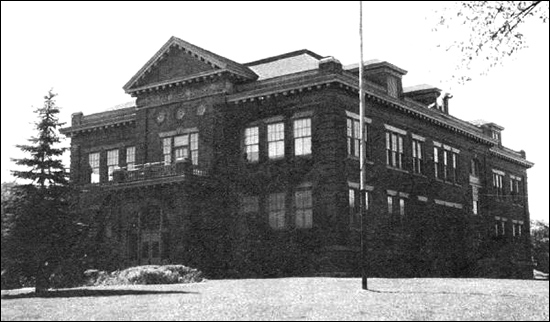School System of Solvay Best Money Can
Buy — No Expense Being Spared in Giving
Children Every Facility for Learning
Solvay people believe they have one of the best school systems in the country. The claim has not been disputed. The three village schools – High, Boyd and Prospect – are as good as the Board of Education can provide, not only in structure and equipment, but in curriculum and the things which go to make the children of today the good citizens of tomorrow.
Their One Endeavor
No one man or group of men can be given credit for the school system as it is. It has grown, just as Solvay has grown, rapidly and well. Superintendents have come and gone, each adding to the general betterment. Boards of education have served their terms and been succeeded by others, each giving of their time and ability to carry out the one principle which prompts all their energies – better service.
There is no such thing as perfection is the understanding of those who have charge of the Solvay schools. That nothing is so good it cannot be bettered is the theory upon which the work goes on there. That is why there are no halts, no time to stop and congratulate one another on the accomplishment of something done, for, by the time it is done there are greater things to do.
Other good men preceded Philip W. L. Cox as superintendent of Solvay schools and wrought much. Mr. Cox took up the work and carried it far ahead. Roy B. Kelley got on the job in September, 1915, and has gone on apace, but the progress is just as regular and systematic as the dally routine in the classroom.
Standing right behind the superintendent is the Board of Education, backing up every endeavor, suggesting where suggestions help and furnishing the wherewithal to carry on the work. These men are: Irvln A. Sidnam, president; S. J. Barber, secretary; Dennis E. O'Brien, M.[ R? P? ] Hazard Jr. and William H. Hart.
Fifty-four teachers compose the teaching corps of the three schools, which have a present attendance of 1,450 pupils. Claude A. Duvall ls principal of the High School and Miss Marie Dunn principal of the Junior High School.
Charles H. Taul is at the head of Boyd School, and Miss Frances Sole in charge at Prospect. A model district school at Lakeland is also under the supervision of the board. It has thirty pupils.
Attendance on Increase
Despite the large number of pupils who left school, particularly the High School, because of war conditions, there are now 100 more scholars in the Solvay Schools than there were one year ago. The school buildings are up to date in every respect. The High School was built ten years ago, and Boyd and Prospect schools were constructed three years ago. They were built for the future, but with the large increase in attendance; it is expected they will be crowded in three years. There are now only two rooms each in Boyd and Prospect schools not used for regular student work.
The parent-teachers associations at the Solvay schools are a feature that is bringing about good results, meetings being held often in the schools for the purpose of examining the work of the pupils, exchanging ideas, enjoying entertainments and mingling socially. The community contact idea is fostered in many ways.
Solvay Companies Help
The Solvay Process and Semet-Solvay companies are lending financial aid to carry on the work of the medical department, and to encourage instruction in industrial arts, household arts, physical training, etc. At the present time grade A milk is being furnished to mothers of small children at 7 cents a quart, 280 quarts being the dally present consumption. Nurses certify to the need before distribution.
In the three schools medical rooms have been completely equipped with hot and cold water, electric stoves, steel dressing tables and all other furnishings. In Boyd School is the dental clinic which is open from 9 a.m. to 5 p.m. every school day and on Saturday mornings. It has been found that 75 percent of the pupils needed dental treatment. Where the children cannot go to another dentist they are treated at the school, temporary fillings being put in for 5 cents and permanent fillings for 10 cents, which, as can be understood, does not cover the cost.
There are employed one physician, one refractionist, two dentists, three trained nurses and one dentist's assistant, respectively, Dr. George M. Relan [?], Dr. Roy S. Moore. Dr. George A. Burdick, Dr. H. Ambrose McMahon, Miss Margaret K. Slocum, Miss Anna B. Chaffee, Miss Margaret M. Ryan and Miss Agnes V. Harvey.
The Junior High School
The Junior High School, opened in the High School building a few years ago, is proving a success beyond expectations. The elementary school takes the pupils through the first six years of study. The Junior High School covers the seventh, eighth and ninth years. Three additional years instruction are given in the high school. The principal aim of the Junior High School is to decrease the tendency of pupils at that age to leave school.
Its classes include the following: commercial, college preparatory, normal, household art, practical art, general industry and academic. It has a savings bank and lunchroom conducted by students. State aid for the general industry course permits boys to gain a practical idea of some trade they may take up for a livelihood.
State aid also helps in the household arts course. The girls buy and cook the foods served in the lunchroom. They estimate the cost and buy with the proceeds of lunches sold. It teaches them how to economize and figure out a weekly pay basis [?], besides giving them instructions in cooking. |

